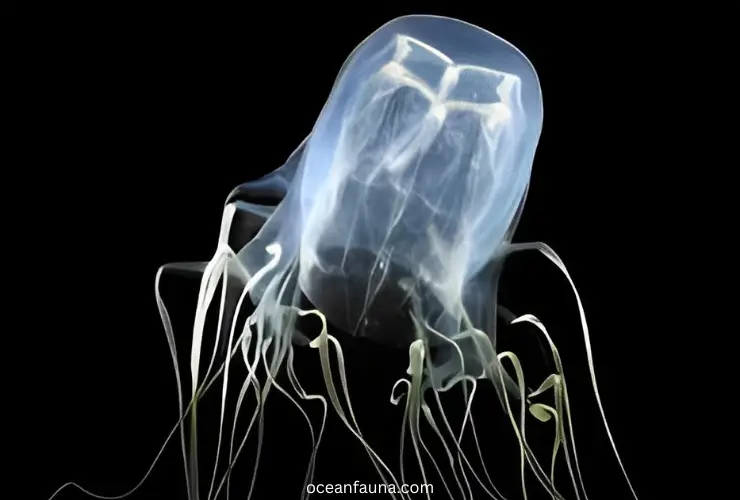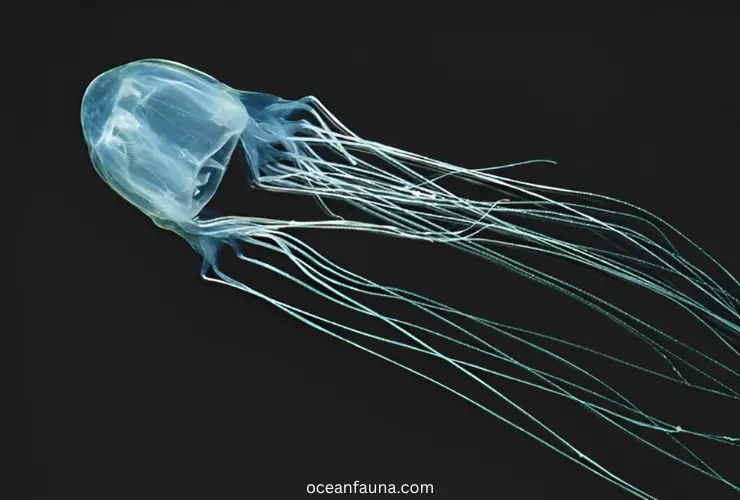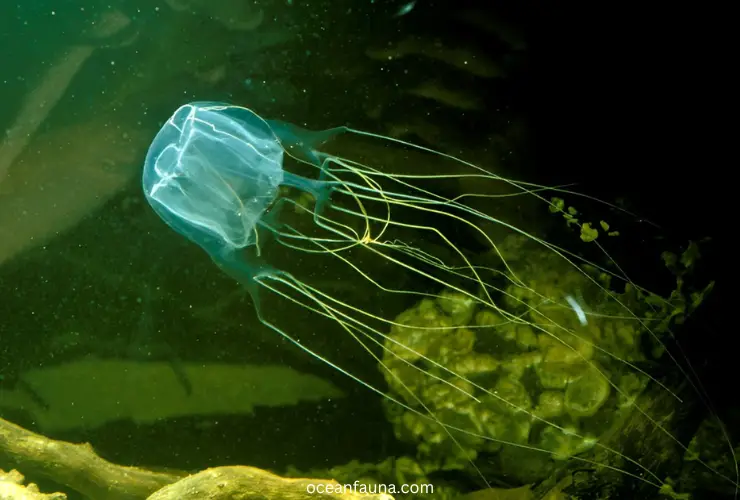The sea wasp jellyfish is one of the deadliest creatures found in the ocean. Its scientific name is Chironex fleckeri. This venomous jellyfish is found mainly in northern Australia and Southeast Asia waters. The sea wasp jellyfish is a formidable predator with its nearly invisible tentacles. It poses a significant threat to swimmers and divers.
Its nickname is sea wasp jellyfish. It is also commonly called Australian box jelly. The sea wasp jellyfish is capable of delivering an incredibly potent venom. Its toxin can cause heart failure and paralysis within minutes. It’s no wonder this creature is considered one of the most dangerous in the ocean.
Have you ever heard of the deadly sea wasp jellyfish? Did you know that its sting is described as feeling like “being whipped by hot wires”? Have you ever wondered what makes this creature so deadly? Well, you’re lucky that you are here. We’re about to dive deep into the world of the sea wasp jellyfish. So, grab your snorkel, and let’s explore together!
About Sea Wasp Jellyfish – A Quick Biology
Here is a quick biology table about the extremely venomous species of box jellyfish. Take a look at these sea wasp jellyfish’s biology facts!
| Parameters | Details |
| Scientific name | Chironex fleckeri (Southcott, 1956) |
| Kingdom | Animalia |
| Family | Chirodropidae |
| Genus | Chironex |
| Phylum | Cnidaria |
| Class | Cubozoa |
| Order | Chirodropida |
| Species | C. fleckeri |
| Habitat and geographical range | Lives in coastal waters of:Northern AustraliaNew GuineaMalaysiaPhilippinesVietnam |
| Lifespan | Maximum one year |
| Diet | Invertebrates and small fish |
| Size | Diameter size: 1 to 30 centimetersTentacles size: up to 3 meters |
| Weight | 2 kilograms |
| Synonyms | Box jellyfish, Australian box jellyfish, Chironex jellyfish, Marine stinger |

Description And Taxonomy of Sea Wasp Jellyfish
One of the extremely venomous species of box jellyfish is commonly known as sea wasp jellyfish. It can be found in the waters of the Indo-Pacific region, particularly in the waters surrounding Australia.
Sea wasp jellyfish has a cube-shaped body and long tentacles that trail from each of its four corners. This jellyfish is translucent and can be difficult to see in the water. This makes it a particularly dangerous creature for swimmers and divers.
According to Oxford University Press, Chironex fleckeri was named after Dr. Hugo Flecker. He was a toxicologist and radiologist from North Queensland. Flecker discovered an unidentified jellyfish after a 5-year-old boy died from a sting on the 29th of December, 1955. He sent it to Dr. Ronald Southcott, who named it Chironex fleckeri. (Source)
It was referring to the four appendages resembling hands. The name derives from the Latin “chiro” meaning “hand,” “nex” meaning “murder,” and “fleckeri” in honor of its discoverer. This lethal box jellyfish is responsible for at least 64 deaths in Australia. It is a significant threat to those who venture into its habitat.
Physical Characteristics / Anatomy of Sea Wasp Jellyfish
Sea wasp jellyfish is one of the largest species of cubozoans. This highly venomous jellyfish has a transparent bell-shaped body that can grow up to 16 cm to 35 cm in diameter. Here are a few physical characteristics of a sea wasp jellyfish:
- It has a pale blue bell with faint markings.
- From each of the four corners of the bell trails a cluster of 15 tentacles.
- Its transparent is transparent with a bluish tint. It can be viewed from certain angles. It resembles a human head or skull.
- A group of 15 tentacles extends from clusters situated at each of the four corners of the bell.
- It has a cube-shaped bell with a box-like appearance.
- The tentacles contain multiple clusters of stinging cells and are arranged in four bunches.
Hope that’s enough physical characteristics to make you want to steer clear of the sea wasp jellyfish!
Behavior of Sea Wasp Jellyfish
Here are a few worth mentioning behaviors of a sea wasp jellyfish:
Swimming Behavior
Sea wasp jellyfish have a swimming behavior that allows them to move through the water. They use their bell-shaped body to push water behind them. This action propels them forward. They can also adjust the rhythm of their bell contractions to swim faster or slower.
Hunting Behavior
Here is another behavior of these creepy creatures. The tentacles of sea wasp jellyfish contract while swimming. This behavior makes their tentacles about 150 mm long. Their diameters contract to 5 mm only. They expend their tentacles and diameter when they are in a hunting mood.
The tentacles of sea wasp jellyfish extend to about 3 m long and are thinner while hunting. These tentacles are covered with cnidocytes that are activated by pressure and chemical triggers. This is how they hunt and catch prey easily.
Nocturnal Behavior
Sea wasp jellyfish are day hunters. They like to rest on the ocean floor at night. This behavior may reduce the risk of encountering predators or prey during a time when visibility is low. However, their transparent bodies, lethal weapons, and larger sizes make them difficult to be hunted by other predators.
Sensitivity to Light
Sea wasp jellyfish are sensitive to light and can detect changes in light intensity. They are attracted to light and may swim toward it. This behavior can sometimes cause them to become stranded on beaches or washed up on shore.
According to the study, they move away from black-colored objects. On the other hand, they are attracted to distinct light colors like red, orange, green, white, yellow, and blue. They extend their tentacles and tend to slow down their pulsation rate in response to blue light. It indicates that they are feeding. ~ source
Habitat, Range, And Distribution of Sea Wasp Jellyfish
The sea wasp jellyfish lives in the open ocean and is found along the coast of Australia and New Guinea, up to the Philippines and Vietnam. It is commonly seen in the northern regions of Australia, from Exmouth to Agnes Water. Their distribution outside of Australia is not yet properly identified.
These jellyfish prefer shallow waters and are often found near the shore or in estuaries. These jellyfish can tolerate a wide range of salinity levels and temperatures. It allows them to thrive in various marine environments. However, they are particularly abundant in areas with warm waters and high salinity, like the tropical waters of northern Australia.
A jellyfish species, Chironex yamaguchii, was discovered in Japan in 2009. It is a new but related species of box jellyfish. It is also venomous and found in the Philippines. This makes it necessary to recheck non-Australian records of C. fleckeri. The breeding of sea wasp jellyfish occurs in lower levels of rivers and mangrove channels.
Feeding Habits/ Diet of Sea Wasp Jellyfish
The diet of the sea wasp jellyfish mainly consists of small fish, shrimp, crustaceans, and other small planktonic animals. They are also known to consume other jellyfish. Overall, the sea wasp jellyfish is a carnivorous predator that plays an important role in the marine ecosystem.
Here is a table summarizing the diet of the sea wasp jellyfish:
| Predator type | Examples |
| Fish | Small fish such as anchovies and gudgeons |
| Crustaceans | Krill, copepods, shrimp, and other small crustaceans |
| Planktonic organisms | Larvae, small jellyfish, and other planktonic animals |

Life Cycle And Reproduction System of Sea Wasp Jellyfish
The sea wasp jellyfish has a complex life cycle consisting of several stages: planula larvae, polyps, and medusae. The medusae are sexually mature and reproduce sexually. Breeding occurs in lower levels of rivers and mangrove channels. The females release their eggs into the water.
This is the time when the males fertilize the eggs. The fertilized eggs develop into planula larvae, eventually settling on a suitable surface and developing into polyps. The polyps reproduce asexually by budding. It involves producing more polyps that eventually transform into the medusa stage, completing the life cycle.
The entire process from fertilization to adulthood can take several months. It also depends on environmental conditions. Once the jellyfish reach maturity, they can reproduce and continue the life cycle. The exact lifespan of sea wasp jellyfish is not known. But, it is believed to be relatively short, possibly only a few months or one year.
This is because jellyfish, in general, have a short lifespan. It is due to their fast growth rate, rapid reproduction, and lack of natural predators. After reaching maturity, sea wasp jellyfish will spawn and release eggs and sperm into the water column.
They die soon after. However, the polyp stage of their life cycle can potentially last much longer. It is because the polyps can reproduce asexually and continue to grow and develop.
Cardiovascular And Nervous Systems of Sea Wasp Jellyfish
Sea wasp jellyfish lack a true cardiovascular system and central nervous system just like other cnidarians. Instead, they have a simple nerve net that runs throughout their body. This network allows for basic sensory and motor functions. They have a rudimentary circulatory system.
This system primarily involves the movement of fluids through the gastrovascular cavity. This system also helps digestion and distributes nutrients to different parts of the jellyfish’s body. Overall, their physiology is adapted to their simple lifestyle.
Sea wasp jellyfish possess 24 eyes arranged in four clusters. These eyes can form images. But, it is still uncertain whether the jellyfish can recognize or track objects with them. Additionally, it does not have a central nervous system. So, how the animal processes information from its touch and light-sensing structures remains unknown.
Importance of Sea Wasp Jellyfish in Ecosystem
The sea wasp jellyfish is an important species in the marine ecosystem. It preys on small fish and crustaceans. It helps them to regulate their populations. However, it is also a dangerous predator to humans and other larger animals that may come into contact with its venomous tentacles.
According to the National Oceanic and Atmospheric Administration (NOAA), the Australian box jellyfish, also known as sea wasp jellyfish, is one of the most venomous aquatic animals. This animal may look cute and adorable but it can send you to the grave. However, there are more than 50 species of box jellyfish that are known as sea wasp jellyfish. But, only a few are venomous, and the Australian sea wasp is one of them. (Source)
Additionally, the sea wasp jellyfish serves as a food source for a variety of predators. This may include sea turtles and certain species of fish. Its presence in the ecosystem also contributes to nutrient cycling and the overall balance of marine biodiversity.
Predators of Sea Wasp Jellyfish
Here is a table that is listing the predators of sea wasp jellyfish:
| Predator name | Habitat / Location | Prey Stage | Species |
| Green sea turtle and leatherback sea turtle | Coastal waters | Juveniles and adults | Chelonia mydas |
| Sea Snakes | Coastal waters | All life stages | Various species |
| Triggerfish | Coral reefs | Adults | Balistidae family |
| Pufferfish | Coral reefs | Adults | Tetraodontidae family |
| Irukandji jellyfish | Coastal waters | All life stages | Carukia barnesi |
| Hawksbill sea turtle | Coastal waters | Juveniles and adults | Eretmochelys imbricata |
| Loggerhead sea turtle | Coastal waters | Juveniles and adults | Caretta caretta |
| Crabs | Coastal waters | Larvae | Various species |
| Fish | Coastal waters | All life stages | Various species |
Relationship Between Sea Wasp Jellyfish And Humans
The relationship between sea wasp jellyfish and humans is not friendly. It’s an enemy-versus-enemy relationship. Humans are predators of sea wasps and sea wasps are haters of humans. Sea wasp jellyfish is considered one of the most dangerous jellyfish in the world, not just for marine animals but also for humans.
Signs and warnings are posted in areas where sea wasps are known to inhabit. Plus, protective gear can be worn to minimize the risk of being stung. Despite their dangerous nature, sea wasp jellyfish are still fascinating creatures. It is said that these sea jellies play an important role in marine ecosystems.

Sea Wasp Jellyfish: The Most Deadliest Known Creature
The tentacles of sea wasp jellyfish are 10 feet long and contain millions of cnidocytes. These cnidocytes release microscopic darts containing potent venom. This can cause excruciating pain upon contact. We have found the following study about sea wasp jellyfish: (source)
“The sea wasp jellyfish is notorious for being the deadliest jellyfish on the planet. It has caused at least 64 deaths in Australia from 1884 to 2021. Its venom is incredibly potent, and its nearly invisible tentacles make it difficult to avoid. This creature is a formidable predator that demands respect and caution from those who venture into its habitat.”
Death within 3 to 5 Minutes
Its sting may lead to death within two to five minutes if left untreated. A single sea wasp jellyfish contains enough venom to kill 60 adult humans. This fact makes it one of the most venomous creatures on earth.
Its venom shocks the heart and paralyzes the lungs. People who survived its venom were in pain for weeks. However, there are many ways to prevent being stung by these brainless creatures. Its sting is very painful and feels like burning.
The sting of sea wasp jellyfish
Sea wasp jellyfish stings cause excruciating pain and a burning sensation. From 1991 to 2004, only 8% of 225 analyzed stings in Australia’s Top End required hospitalization. A single fatality occurred in a 3-year-old child. Severe pain was experienced by 26% of those stung. Children are at higher risk of death due to smaller body mass. (Source)
According to NCBI research, we have found the following facts about its venom: (source)
“The venom of the sea wasp jellyfish causes hyperkalemia. This is the reason that leads to cardiovascular collapse and death within minutes. The LD50 of the venom is 0.04 mg/kg. Researchers are exploring a possible zinc compound antidote. Sometimes, swimmers get stung and suffer cardiac arrest or drown before reaching safety.”
Chironex fleckeri and other jellyfish are common in northern Australia’s waters during warm months. They enter estuaries to breed. Warning signs are placed along the North Queensland coast to alert people of their presence. (Source)
Still, few people swim during this period. However, some still do, putting themselves at risk. Popular swimming areas have net enclosures to keep jellyfish out and swimmers safe.
Historical Treatment of Sting
The treatment for Chironex fleckeri stings has evolved. Historically, vinegar was used to wash the affected area and remove tentacles. However, this method is no longer recommended as it can cause further discharge of nematocysts.
Instead, it is recommended to rinse the affected area with salt water and carefully remove any visible tentacles with tweezers. Applying heat packs and immersing the area in hot water (45°C) can also help to alleviate pain. In severe cases, antivenom may be administered.
FAQs
Are sea wasp jellyfish immortal?
No, sea wasp jellyfish are not immortal. They do have the ability to revert to their juvenile form after reaching maturity. They can still die from various causes such as disease, predation, and environmental factors.
Are sea wasp jellyfish endangered?
Sea wasp jellyfish (Chironex fleckeri) is not currently listed as endangered. They are a common species found in the waters of northern Australia and are not considered to be threatened by extinction. However, the impact of climate change on their habitat and prey availability is a concern. It could potentially affect their population in the future.
Is the box jellyfish the same as the sea wasp?
Yes. The box jellyfish is the same as the sea wasp. Both are often used interchangeably to refer to the same group of jellyfish species. However, it is important to note that not all jellyfish referred to as “sea wasps” are true box jellyfish.
It is because other jellyfish species are also commonly called by that name. Additionally, many box jellyfish species are extremely venomous and dangerous to humans. But, all sea wasps are not necessarily harmful.
Conclusion
So, we have come to the end of our adventurous journey about the sea wasp jellyfish. We’ve learned that these little creatures are not to be trifled with. However, we can still appreciate their unique beauty from afar. Let’s stay safe when swimming in their waters by following precautionary measures.


1 thought on “Sea Wasp Jellyfish: Habitat, Diet, Description & Facts”